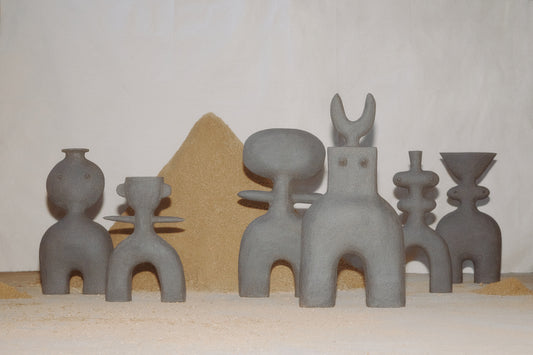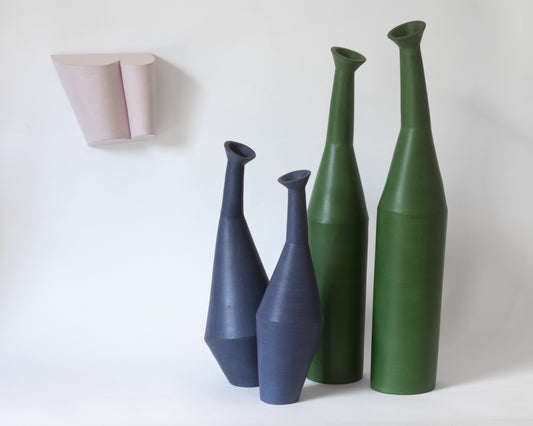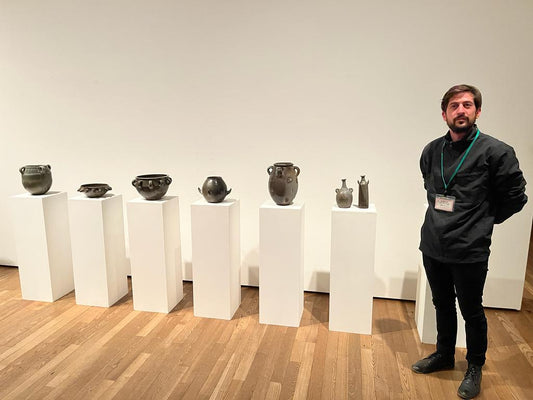In North America the categories of contemporary craft/functional art seem to be in movement, and perhaps merging, with the traditional fine art category. Do you sense that same movement in the East? Or were functional ceramics/ traditional pottery always considered fine art in the East?
I think you are absolutely correct. The categories of fine art and craft have shifted greatly in the West recently. Bringing craftwork into the fold of collectibles and allowing people with less formal academic or artistic backgrounds to reach wider audiences. Possibly due to the influence of social media. People can now get recognition without the consent or backing of well-known, large, galleries or museums. Giving a broader platform to smaller makers from the more utilitarian side of the map to shine.
In my opinion, what might be the biggest difference between East and West is the definition of things. In the West, there is a growing appreciation for what you called “functional art” or “collectible design”. Some kind of merger between the two. Where craft technologies are applied to create objects without function, or sterilized of their function. Whereas in Japan, fine art holds a place of its own, separated from craft. Or maybe better said, craft has a place of its own, separate from art, with its own status and set of values. This is not to say that this merger between categories doesn’t happen in Japan, it does. Young Japanese artists/craftsmen are also using craft technologies to create art. But once they sterilize the function it’s not craft anymore, it’s simply art. It becomes what the Japanese call オブジェクト, which is literally the word “object” taken from the English language and made Japanese. Meaning something static, without function, a work of art.
What I do find much stronger in Japan is the appreciation and collection of functional, everyday ceramics. From plates and cups to tea ware, vases, and other everyday objects, things that the viewer could imagine holding and using and aging with. Through the ages, there was always an appreciation for the simply functional, for the materials used, and the quality of the work. Whereas in the West it seems to be something new. This is not to say that there weren’t surges of appreciation in the West, for instance in the times of the arts and craft movement, but they were inconsistent and not so widely spread as in Japan.
What were your goals in pursuing a Masters in Ceramic Craft in Japan? What was the desired outcome? Do you feel like your objectives were achieved?
Honestly, my goals were no less financial than artistic or academic. As a practicing artist at the beginning of your career, it can be difficult to support yourself financially and also develop artistically. Finding the time to make work that is not for profit but for your personal development or exhibitions can be tricky. The opportunity to come and study in Japan came with a scholarship provided by the Japanese government. This paid my tuition fees along with a monthly allowance, allowing me to focus on making new work without constantly worrying about the bills. Of course, this all sits under the umbrella of studying in Japan, soaking up Japanese aesthetics, learning traditional Japanese techniques, meeting local craftsmen, and directing my work on Japanese craft. All while obtaining a master’s degree that could someday move me closer to the academic teaching position I am aiming for.
One of the biggest achievements for me here was meeting and working alongside artists that I thought were unreachable, some of the people I appreciate most in the ceramics world. It has been a rare opportunity to meet excellent craftspeople and fire some of the biggest kilns I have ever seen. In addition, my wife (a wood artist) and I opened up an online shop, Sentomono, to sell our work, as well as the work of young Japanese craftspeople. Our goal is to showcase the excellent skill and labour that is often undervalued in the West and to create some kind of bridge between Japan and the outside world. The ability to meet new craftspeople and serve as a conduit between the eastern and western worlds was, and still is, a big part of my stay here.
So, overall I think coming here was a good choice. I finished my degree and potentially moved closer to a teaching position. I learned a lot about traditional techniques and Japanese crafts in general. Moreover, my time here is invaluable because of the human connections I have formed through travels, the university, and the shop. Connections that could last a lifetime and provide continuous growth, both financially and artistically.
In terms of the degree, what was the focus? Was it on technical skill, creative expression, experimentation, or historical context? Or a combination of many things? Which part was particularly meaningful to you? Which aspect challenged you the most but was most satisfying as far as your growth as an artist?
To my surprise, doing an MFA in ceramic art at the Tokyo University of the Arts was very relaxed. There were zero to no requirements. It felt more like operating as a private studio inside the university than an actual master’s degree. Before coming here I had this image in my head of a strict Japanese Sensei constantly correcting me and telling me I’m doing it all wrong. But in reality, the only requirement we did have was to build a wood-firing kiln in the first year and to present a final project at the end of the second. None of these had any guidelines. We got to choose what kind of kiln we wanted to build and what our final project was. Things were not structured in any way, unlike my bachelor’s degree which moved from technical development through cultural contexts to artistic expression. Usually, all three would advance together in some way. Here, new projects, based on cultural context, would require technical advancement and research, which would later give birth to projects that put these new technical achievements at the front. Hopefully a line of artistic expression would run through everything.
I think the most meaningful part for me was expanding my knowledge and experience in wood firing. In the three years I have been here I have designed, built, and fired my own kiln. I have watched my classmates build and fire their own kilns and learned a lot about kiln structures and traditional building methods. I fired many other kilns in and out of the university and met other kiln builders and other potters focused on wood fired pottery. Constantly gaining a deeper understanding of the ways in which Japanese wood kilns work. I picked up small tricks to get different results, learned how how to pack kilns and clean them out. I also learned about the materials used, how to make glazes for wood firing, or what clays fire beautifully unglazed. There is so much knowledge here and I think my learning about wood firing techniques has had the largest contribution to my personal work.
What was your experience as an international student? How was your previous experience perceived and did you feel that the work you created during your time in the program was valued?
I believe that there was interest in my work. Being non-Japanese I naturally took different approaches. Switching regularly between “design art” projects and traditional crafts and constantly trying to merge the two. I think that was a bit strange for my classmates and professors at first. This constant switching, as Japanese craftspeople usually stick to the same line of work for a very long time making only micro adjustments to their work. But once I started producing work, I think it was valued. I made an effort to understand and a make some of the less practiced traditional Japanese ware. Forms like the Katakuchi (pouring cup), Soba Choko (Soba cups), Tokkuries (Sake Bottles) or Guinomies (Sake Cups). And overall, I think I did an ok job at that. Keeping things simple and clean and finally receiving good critiques from Japanese customers, teachers and schoolmates.
Moreover, I believe my presence within the Japanese academy changed some of the views of other students. It definitely changed mine. I think my presence showed some of the Japanese students that there is more than one way to do something. That there are people out there who think and act differently, and it’s ok. I definitely learned new ways to do things, I learned patience and calmness and thoroughness. And i am better for it. In the end, when we go abroad and meet new people and immerse ourselves in new cultures, we can only hope to change and to be changed for the better.





